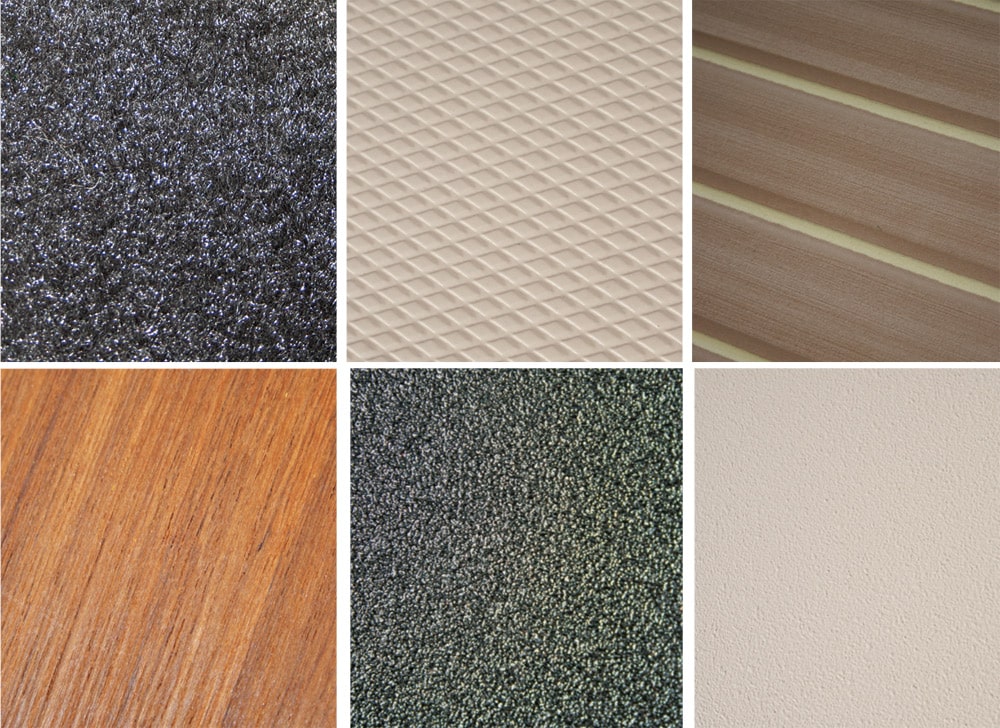
Choosing the Best Nonskid Surface
Top 8 countdown of what’s got grip and what might slip.
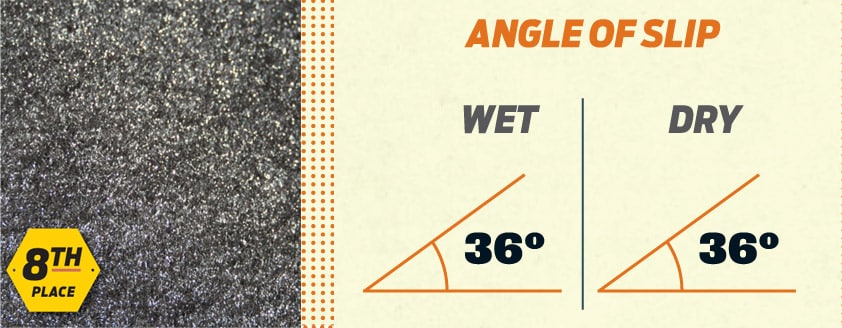
Choosing the Best Nonskid Surface
While we had expected boat carpet to offer better traction than most, it was actually the least grippy of any of the deck coverings. The good news is that water does not seem to degrade its mediocre nonskid qualities. Our deck shoe held up to the same angle whether pile carpeting was dry or soggy. Comments
Most of the water stayed put rather than running off when the angle of the ramp was increased. If you want a carpeted deck, opt for snap-in that’s easy to pull out and dry, or buy a wet-dry shop vacuum. Pros
Boat carpet retains its nonskid qualities when the deck gets wet. Cons
Carpeting is slow to dry, leading to wet feet and greater chance of slipping elsewhere.
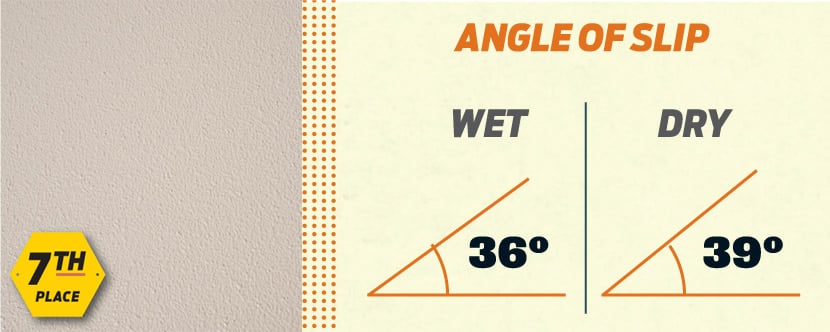
Choosing the Best Nonskid Surface
Fiberglass grit-style nonskid offers good traction when dry but loses some grip when wet. While most of the water beaded up and ran off quickly as we increased the angle, the texture retained some water, and we believe this led to the reduced grip in our wet test of this surface. Comments
To confirm these results, we tested fiberglass grit-style nonskid surfaces from other sources, but we found that Grady-White offers the best grip, if not the most gritty texture, in this category. Pros
When dry, this surface offers just as much traction as diamond nonskid. Cons
A tendency to hold minute amounts of moisture leads to loss of traction when wet.
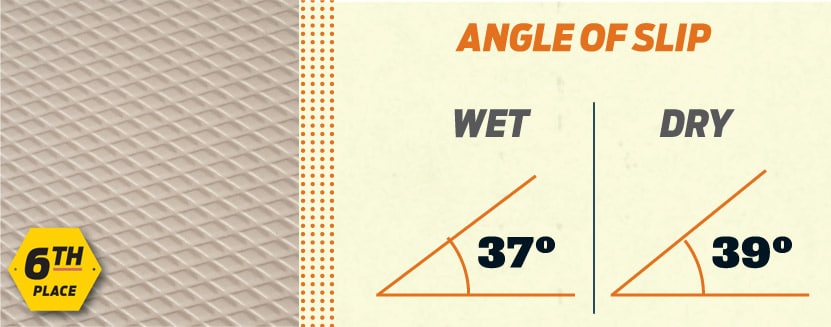
Choosing the Best Nonskid Surface
The diamond-pattern fiberglass sole in our comparison displayed good traction while dry, and it lost a little grip when wet. Most of the water ran off quickly, with the rest collecting in the tiny channels in the pattern, leaving the raised diamonds largely dry and ready to grab. Comments
We also cross-checked these results against other diamond patterns and found this one — used by Grady-White — provided the best traction. The lesson here: Not all diamond patterns are created equal. Pros
When new, this nonskid offers good traction whether it’s wet or dry. Cons
Nonskid qualities will degrade with age as the deck wears from use and scrubbing.
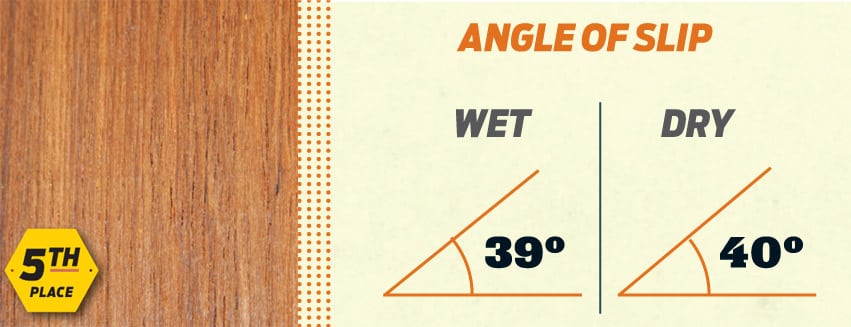
Choosing the Best Nonskid Surface
Tested with the grain running parallel to the ramp, a sheet of untreated teak proved to offer better traction than both types of the fiberglass textures, as well as the carpet, in our comparison. While much of the water ran off, the wood remained damp, degrading traction in the wet test. Comments
When completely dry, teak lives up to its old-school reputation for grip. However, when traversing a damp deck in the same direction as the grain, you can’t count on the same traction. Pros
Even when wet, teak offers the same degree of traction as either fiberglass nonskid. Cons
Untreated teak tends to take longer to dry than fiberglass nonskid or faux teak.
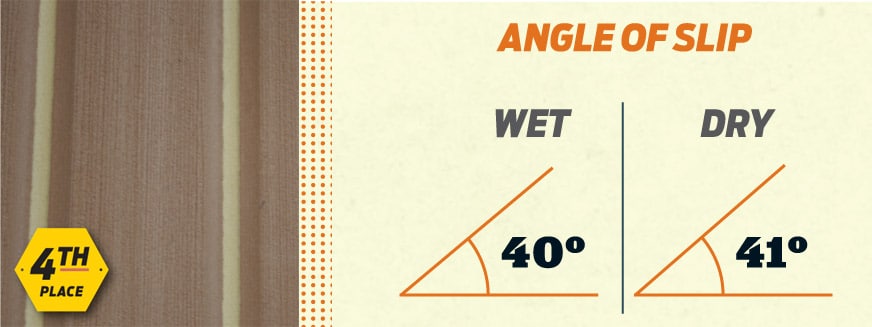
Choosing the Best Nonskid Surface
To get a complete picture, we tested a sample of SeaDek faux teak two ways — with the grain and across it. The grain and simulated caulking channels are machine-cut. Our first test going with the grain was impressive. SeaDek maintained a strong grip when wet. Comments
The EVA foam decking material shed almost all of the water immediately as the incline increased, absorbing none of the moisture. Traction was only slightly degraded in the wet test. Pros
Very grippy wet or dry, with the added benefit of foam cushioning underfoot. Cons
Caulking channels can collect dirt, fish scales and other gunk if not cleaned properly.
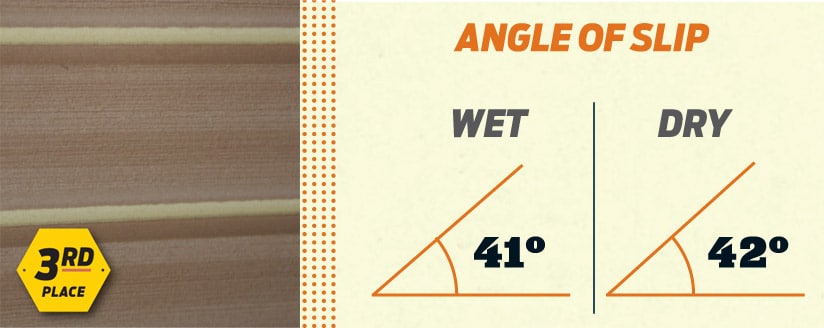
Choosing the Best Nonskid Surface
Traction improved even further in our tests of SeaDek across the manufactured grain. The edges of caulking grooves, which ran crosswise to the ramp in this trial, might have also contributed to better traction. When wet, SeaDek lost very little of its grip. Comments
While the simulated planking shed water quickly, half-inch caulking grooves held pockets of water, which gradually emptied as the ramp angle increased. However, this did not seriously degrade traction. Pros
Traction of this EVA foam material is good, but it grips even more across the grain. Cons
Water collects in the caulking grooves, so drainage needs to be carefully considered.
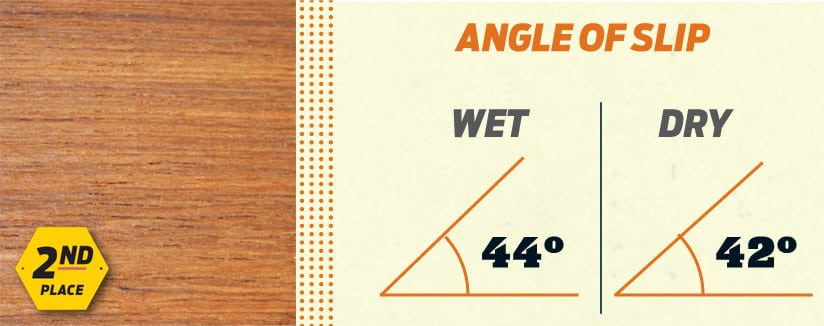
Choosing the Best Nonskid Surface
As with SeaDek, we retested teak across the grain. While offering impressive traction when dry, it was the only surface that became more grippy when wet. We believe this is because moisture raises the grain of the wood, creating cross-ridges of nonskid. Comments
The salty assertion that teak is the best nonskid sole holds some water (excuse the pun). While traction proved very good overall, it was outstanding when measured across the grain while wet. Pros
This is the only nonskid material that offers improved traction when it’s wet. Cons
Teak decks are heavy and expensive, making them best suited for larger boats.
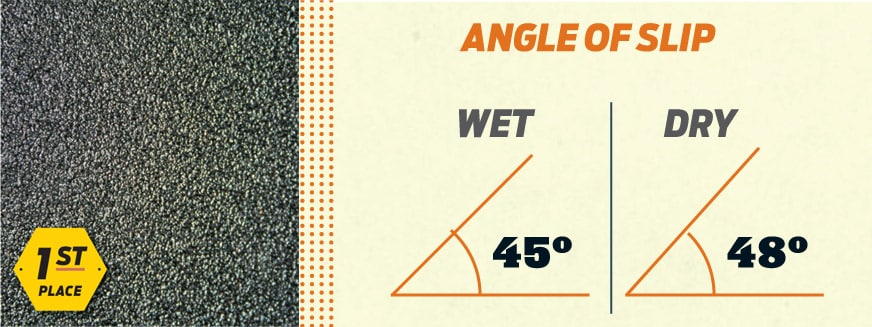
Choosing the Best Nonskid Surface
3M set out to create the best traction possible — largely for industrial applications — and it succeeded with this grip tape. More popular among skateboarders than among boaters, this material offered extremely good traction. Even wet, it had better grip than any other material in the group. Comments
3M is known for the ultimate — as in 3M 5200 series — sealant. Safety-Walk 700 series carries this philosophy into the genre of nonskid. It offers extremely strong grip whether it’s wet or dry. Pros
Available in a variety of widths and lengths, this peel-and-stick material is easy to apply. Cons
The tape begins to peel up at the corners after a year or two of use, requiring replacement.
It was the Age of Discovery, and brave sailing captains gazed skyward in quest of better ways to navigate. Yet, their crews more likely looked down and muttered, “We’ve got to do something about this slippery deck.”
Today, some boaters still look down and wonder how to make decks less slippery. To find some answers, we returned to the Age of Discovery and an ancient, but still relevant, test described in the notes of Renaissance man Leonardo da Vinci (1452-1519).
Da Vinci contributed immensely to things nautical, his engineering sketches depicting objects we now know as submarines and propellers.
I’m not sure if da Vinci ever thought about slippery decks, but he was the first to conduct quantitative studies on the subject of friction, an inherent attribute of a good nonskid sole.
One of his test apparatuses was a ramp with which he could gradually increase the angle of incline until an object began to slip downward. The greater the angle, the greater the friction between the object and the surface. Based on the results of this experiment, da Vinci also defined the mathematical formula for calculating the coefficient of friction.
If it was good enough for da Vinci, it was good enough for us. Besides, the variable pitch of of his device seems to replicate the heaving deck of a boat on a bad day. And isn’t that when you value good nonskid the most? With this in mind, we built a ramp similar to da Vinci’s and used it to test some of today’s most popular types of deck surfaces.
It’s one thing to test nonskid when it’s dry, but the deck on my boat is rarely that arid. Thanks to mist, spray and liberal use of the raw-water washdown hose, a lubricating film of moisture — not to mention fish slime and spilled coffee — usually coats the deck. So no testing of this sort would be complete without including wet surfaces, as well as dry.
Da Vinci’s experiments were born of a desire to find ways to overcome friction, which in many circumstances can be your enemy. But not when it comes to the deck. Here, friction equals traction, and traction equals safety. That’s my da Vinci code.
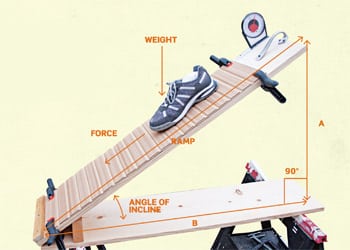
Da Vinci Device
To compare the traction of nonskid surfaces, we followed the writings of Leonardo da Vinci and built a device similar to one he described in his studies of friction five centuries ago.
Leonardo da Vinci’s experimental setups for measuring friction were pretty simple. One of them was a variable incline plane with which he could measure the angle at which an object began to slide on a given surface. He then used a mathematical formula to calculate the coefficent of friction between the surface and the object. Today this is known as the static coefficient of friction.
To build a replica of da Vinci’s device, we used two straight and level boards hinged at one end. To the top board, we clamped samples of new nonskid material. For the object, we used a new deck shoe weighted with 11.43 pounds of lead sinkers, for a total weight of 12.35 pounds. OK, that’s a lot less than what a typical boater might weigh, but it was equally weighted for all surface testing, allowing us to draw conclusions about which nonskid materials offer the best traction.
Using an inclinometer, we recorded the angle at which the shoe began to slip with the surfaces dry, and then repeated the tests after pouring one cup of fresh water on each surface just before positioning the shoe (with a dry sole) and gradually increasing the angle. To learn what the da Vinci device taught us, turn the page.
Do the Math
You can use the da Vinci device to calculate how much force (F) is needed to move an object. First calculate the static coeffecient of friction by dividing A (measured when the object first slips) by B; then multiply that number by the weight (W) of the object, as in: F = (A/B) x W. This will tell you the amount of force needed to initiate slippage.
Nonskid Row
Decks take many forms, each offering a different set of benefits and drawbacks aside from its nonskid qualities. The six types of boat decks we tested include some favorites, as well as a couple that aren’t exactly classics.
Boat Carpet
We chose the marine pile you might find in runabouts, freshwater fishing boats and pontoons. It’s soft and has a quieting effect, a big help on fish boats. However, it can trap moisture, leading to mold and rot on plywood decks. Though they show dirt and stains, light colors remain cooler in summer months than dark colors.
Diamond Nonskid
This pattern ranks high among fishermen for its ability to clean up well after being fouled with tracked-in dirt, slime and such. However, it is tricky to repair if chipped. Aggressive patterns can stab at bare feet, though this one used for Grady-White soles is comfortable, even on tender tootsies.
SeaDek
SeaDek (seadek.com) custom-made decking uses machined, stain-resistant, nonabsorbent EVA foam to simulate teak with a bit of cushion. There’s little maintenance, and a square yard weighs about 12 ounces, much lighter than teak. Dark teaklike colors can get hot, so SeaDek also offers lighter hues like holly and gray.
Teak
Some believe teak offers better traction than any modern nonskid. The key is to let it weather, washing it only with salt water. Teak oil ruins its nonskid properties. Untreated, it will turn gray, and some find this aesthetically unappealing. Teak decking is heavy and susceptible to stains from oil, fish blood and squid ink.
3M Safety-Walk 700
Grip tape is found on some aluminum boats. We used 3M Safety-Walk 700 series 4-inch-wide tread ($4.99/foot, westmarine.com), which is akin to course sandpaper, tough on bare feet and aesthically questionable. The black tape gets hot, but cooler white is available in a less-aggressive tread.
Grit Nonskid
This gelcoat version of grip tape is found on many boats. Ours was sampled from the gunwale of a Grady-White. Chips and scratches can be tricky to fix but easier than with diamond nonskid. Some grit patterns tend to retain dirt and can also be painful on bare feet, though the G-W pattern felt quite comfortable without shoes.
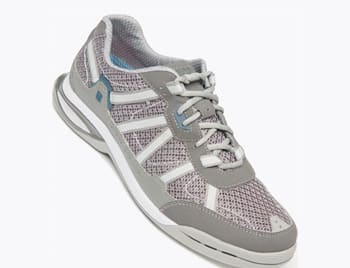
Get a Grip: Sperry Kingfisher
To serve as the test object, we chose a deck shoe — not any shoe, mind you, but the winner of our BoatingLAB “Boat Kicks” comparison. The Sperry ASV Kingfisher ($140/pair, sperrytopsider.com) features Sperry’s famous Wave Siping rubber outsole for traction on wet and dry surfaces. The fine tread squeegees away water without picking up grit that can scratch the deck. Of 11 boat shoes we tested, it gripped best on wet surfaces, making it an obvious selection for our nonskid comparison. The Kingfisher also features the ASV-cushioned sole to dampen shock and vibration, and its low-absorbent, quick-drying material helps keep feet dry. It is available in gray and white, in men’s sizes 7-13. Our test shoe was size 11.









